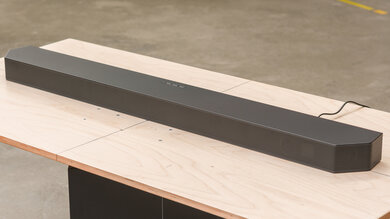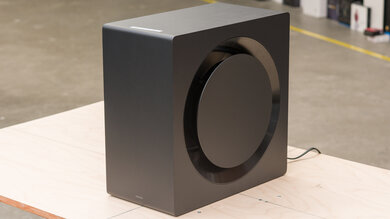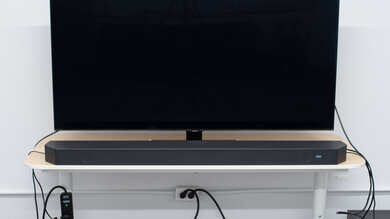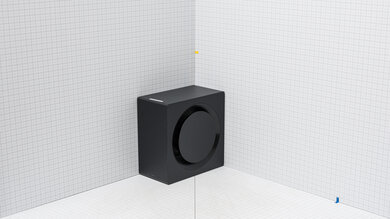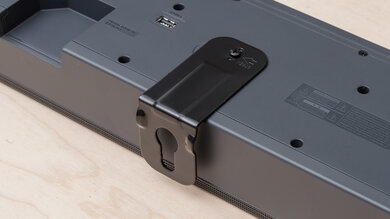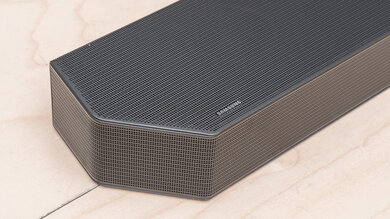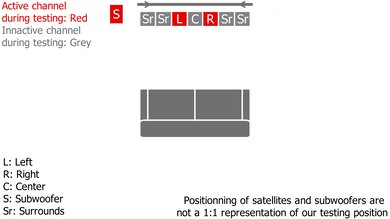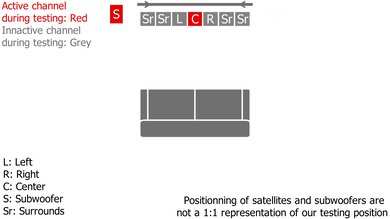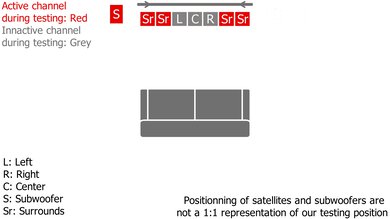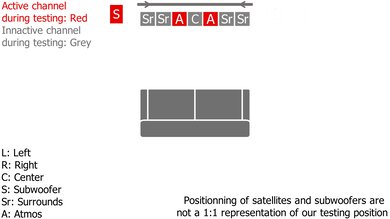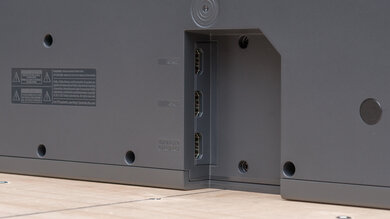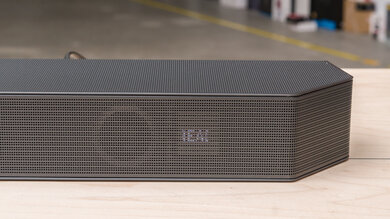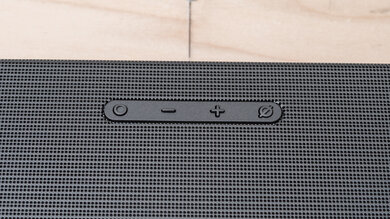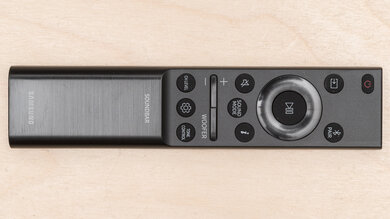The Samsung HW-Q900C is a 7.1.2 setup released in 2023 as the next generation of the Samsung HW-Q900A. It's a feature-packed bar that supports many different audio formats commonly found on your favorite streaming platforms and Blu-rays, like Dolby Atmos, and it offers improved sound quality compared to the previous generation model. As with most Samsung bars, there are lots of sound customization tools on hand, too, from the SpaceFit Sound Pro room correction tool to Q-Symphony integration with compatible Samsung TVs. Built-in Alexa gives you hands-free control, too. Since it comes without dedicated satellites, this soundbar is an especially great option for those without space for them behind their couch.
Our Verdict
The Samsung HW-Q900C is excellent for mixed usage. This 7.1.2 soundbar is a great pick for those who don't have space behind their couch for dedicated satellites in their living room. With a clear and detailed sound out-of-the-box, you can enjoy everything from music to movies to TV shows. The sub also brings all the rumble in the low bass for genres like EDM and hip-hop. Without satellites, you don't get the same life-like feel as with more premium bars when listening to Dolby Atmos and other height content.
-
Room correction feature.
-
Extended low-bass.
-
Supports Dolby Atmos.
-
No discrete satellites included.
The Samsung HW-Q900C is amazing for dialogue-centric podcasts and TV shows. This bar has a discrete center channel designed to improve vocal reproduction. Dialogue is clearly and accurately reproduced, too, so it's easy to follow along with the conversation on screen. Plus, the dialogue enhancement tool gives you extra control over the quality of voices in the mix. Latency is fairly low, too, and you can always use the audio sync tool to manually adjust the delay to avoid lip-synching issues.
-
Room correction feature.
-
Dialogue enhancement tool.
-
Bluetooth, Wi-Fi, Apple AirPlay support.
-
No Chromecast built-in.
The Samsung HW-Q900C is excellent for music. This soundbar offers a balanced sound right out of the box, suitable for listening to many genres. Voices and other lead instruments are clear and detailed in the mix. The sub brings rumbly bass but struggles with the deepest frequencies, which can be noticeable in very bass-heavy music. Still, you have lots of sound customization tools on hand. The room correction tool optimizes the bar's sound based on your room's unique acoustics, while a 7-band graphic EQ and bass and treble adjustments are on hand for manual customization.
-
Room correction feature.
-
Extended low-bass.
-
Bluetooth, Wi-Fi, Apple AirPlay support.
-
No Chromecast built-in.
The Samsung HW-Q900C is great for movies. This soundbar supports many audio formats commonly found on streaming platforms and Blu-rays, including Dolby Digital and Dolby Atmos. Though it lacks discrete satellite speakers, it still provides an immersive listening experience to bring all the action on screen right into the comfort of your living room. Dialogue is clear and easy to follow, while the sub brings the thump and rumble in action-packed scenes. You won't get the same sense of sound effects stretching into the space behind your couch without satellites, though.
-
Extended low-bass.
-
Dialogue enhancement tool.
-
Supports Dolby Atmos.
-
No discrete satellites included.
- 8.5 Mixed Usage
- 8.8 Dialogue/TV Shows
- 8.5 Music
- 8.2 Movies
Changelog
- Updated May 21, 2024: Per TBU 1.3 methodology, we updated the text in the Stereo Sound boxes after retesting with the manufacturer's recommended settings. Also added text to Audio Latency: ARC, Audio Latency: HDMI In, and Audio Latency: Optical boxes. Some updates to the usages as well, in line with these changes.
- Updated May 16, 2024: We've converted this review to Test Bench Update 1.3. If applicable, we've retested stereo sound based on the manufacturer's recommendations. Additionally, we've expanded our audio latency tests to the following boxes: Audio Latency: ARC, Audio Latency: HDMI In, and Audio Latency: Optical. You can see the full changelog here.
- Updated Oct 06, 2023: Added market comparison with the Samsung HW-Q930C in the Style - Satellites box.
- Updated Jul 12, 2023: Review published.
- Updated Jul 07, 2023: Early access published.
Check Price
Differences Between Sizes And Variants
The Samsung HW-Q900C is available in Black, and you can see the label for the model we tested here.
If you come across another version of this soundbar, let us know in the forums so we can update this review.
Compared To Other Soundbars
The Samsung HW-Q900C is a mid-range offering in the manufacturer's 2023 lineup. It falls between more premium models like the Samsung HW-Q990C and the Samsung HW-Q930C, which come with discrete satellites, and more budget-friendly offerings like the Samsung HW-Q800C. As with most Samsung bars, it gives you access to many different customization features, and you can always upgrade it with satellites down the line. As the next generation of the Samsung HW-Q900A, it also brings some small improvements in sound quality.
See also our recommendations for the best soundbars with a subwoofer, the best Dolby Atmos soundbars, and the best Samsung soundbars.
Since the Samsung HW-Q900C has a dedicated subwoofer, it can bring a more extended low-bass compared to the standalone Sonos Arc. You can always compare the Samsung with setups like the Sonos Ultimate Immersive Set with Arc and the Sonos Arc with Sub + One SL Speakers to understand how the bar performs with a sub added on. Either way, it does well for a standalone bar, so it may be more suitable if you don't have space for a sub in your living room.
The Samsung HW-Q900C is a more premium alternative to the Samsung HW-Q800C—notably, the Q900C is a 7.1.2 setup with two additional surround channels compared to the 5.1.2 Q800C. You notice this difference with surround sound and height content, as the Q900C brings a more immersive sound. It gets louder with less compression at max volume, too.
The Samsung HW-Q990C is a more premium alternative to the Samsung HW-Q900C. Both setups have the same bar and subwoofer, but the Q990C adds satellites for better surround sound. The satellites improve the height performance, too, as you notice more sound effects in the space behind you. The Q900C is still a good option if you don't have space for satellites.
The Samsung HW-Q900A and the Samsung HW-Q900C are similar 7.1.2 setups. However, the newer Q900C has some small improvements over its predecessor—notably, it gets louder with less compression at max volume, and its sound quality is a bit more even out-of-the-box. It has a better build quality, too.
The Samsung HW-Q930C is a more premium alternative to the Samsung HW-Q900C. The HW-Q930C has rear satellites, offering better height and surround sound performances, especially when you account for more subjective elements like the overall soundstage. The HW-Q900C is a good alternative if you don't have space for satellites in your setup.
The Samsung HW-Q930B is better than the Samsung HW-Q900C. The Q930B has discrete satellite speakers, which noticeably improve its surround sound and Atmos performances compared to the Q900C. The Q900C is a good alternative if you have a smaller living room without space for extra satellites.
Test Results
The Samsung HW-Q900C comes with the same bar as the Samsung HW-Q990C. It's mostly made of metal and good-quality plastic, with angled sides for a hexagonal look. There's a display screen in front and some controls on top.
The sub also matches the model that comes with the Samsung HW-Q990C. It has a rectangular shape, and there's a plastic plate covering the woofer in the front. The manufacturer advertises that there's an acoustic lens inside that helps it reproduce smoother bass, too. You find the port in the rear.
You can buy compatible satellites from the manufacturer separately, or check out a model like the Samsung HW-Q930C that comes with satellites included.
The Samsung HW-Q900C has excellent build quality. This premium setup is made of strong, sturdy materials that withstand traditional wear and tear. Metal grilles on the bar help protect the drivers inside, which is a nice touch. You won't find any fabric on the bar or the sub, either, so you don't have to worry about hair or dust clinging to the bar.
The Samsung HW-Q900C offers a great stereo frequency response. As with Samsung's other premium models, it comes with a room correction tool designed to optimize audio reproduction based on the unique acoustic characteristics of your living room. You get a nice, neutral sound with stereo content, especially in the mids, where most voices and lead instruments are reproduced. The dedicated sub brings the thump and rumble in the low-bass as well. Overall, this soundbar is suitable for listening to many different music genres, even if it struggles with the low-bass frequencies found in tracks like 'Stay' from the Interstellar soundtrack.
If you prefer a more neutral sound with stereo content, leave the bar at its default settings. There are many customization tools on hand if you want a different sound, which is nice.
The bar's stereo soundstage is good. It's perceived to be a tiny bit wider than the bar itself, though it doesn't have any tricks to make it seem wider than that. Still, it has good focus, so it's easy to follow specific instruments and sound effects to a pinpoint location in the soundstage.
This bar gets loud and is a great choice for listening to audio in larger and more open spaces. There isn't a lot of compression when you push it to max volume, either, so you enjoy a clean and clear reproduction of your audio.
The Samsung HW-Q900C has a discrete center channel designed to improve vocal reproduction in the mix. The channel's frequency response is quite even and balanced, ensuring that dialogue is clear and easy to follow in your favorite movies and TV shows.
Unlike the Samsung HW-Q990C, this soundbar lacks discrete satellite speakers. Instead, it uses side-firing channels built into the bar to simulate a phantom surround. These channels offer a balanced frequency response that ensures sound effects are clear and accurate in the mix. However, the overall feel of surround sound isn't as clear or as real as what you get with models with discrete surround speakers. Audio seems to come from a speaker placed in front of you rather than from around your room.
The Samsung HW-Q900C has two up-firing drivers that ricochet sound off your ceiling to create the illusion of height with content like Dolby Atmos. Again, these channels have a pretty even frequency response, so sound effects are clear and detailed. Without satellites, you don't have any up-firing drivers placed behind your couch, though, which does take away from the overall immersive feel a bit, especially compared to models like the Samsung HW-Q990C.
Additionally, we subjectively evaluate the bar's soundstage performance with height content. It offers a very good sound overall, especially for a setup without discrete satellites. The front hemisphere is immersive and life-like, with a good sense of height. You notice a clean and clear reproduction of sound effects to your left and right, too. Of course, you don't notice as much detail in the space behind you, but if you don't have room for discrete satellites, this setup is a really good option.
As with most soundbars from the manufacturer, the Samsung HW-Q900C has many sound customization tools. The SpaceFit Sound Pro room correction tool is designed to automatically optimize the bar's sound, but you can adjust it manually, too. The 7-band graphic EQ is available in Standard mode, and you get access to more traditional bass and treble adjustments when in Surround, Adaptive Sound, or Game modes. The 'CH Level' button on the remote lets you adjust the center, side, wide, and front top levels, and you can also adjust the rear levels if you add on satellites. The Samsung SmartThings companion app is a handy way to adjust these features from your smartphone, too. Plus, if you own a compatible Samsung TV, you can link it up with the bar to integrate the TV and soundbar's speakers.
You can connect the bar to your TV using Optical or HDMI. Two Full HDMI In ports are on hand, too, which is great for video passthrough with your TV and another device like a PC. There's a USB port underneath the bar, too, but it's only designed for service updates, and you can't use it for audio playback.
This soundbar supports many different audio formats commonly found on both streaming platforms and Blu-rays, including 5.1 surround sound like Dolby Digital and lossless and object-based formats like Dolby Atmos.
Similarly, the bar supports lots of audio formats over HDMI In. It can playback common 5.1 surround sound formats like Dolby Digital and lossless and object-based formats.
Over Optical, the Samsung HW-Q900C supports the most common surround sound format in Dolby Digital. DTS is less commonly found on its own, but it's often used as the fallback for the higher-quality DTS HD-MA format on certain Blu-rays.
This bar has excellent latency performance via ARC. You likely won't notice much delay between your audio and visuals. While some apps and TVs compensate for latency, you can use the companion app's Audio Sync feature to adjust for delay.
The bar's latency performance via HDMI is amazing. You don't notice a delay between the audio you hear and the video you see on screen, which is great. Plus, Samsung's Audio Sync feature is on hand in the SmartThings app, so you can manually adjust the delay to your liking. It's especially handy, given that some apps and TVs compensate for latency differently.
Over Optical, you'll also experience an outstanding latency performance. You aren't likely to experience delays between your audio and visuals. Although some apps and TVs compensate for latency differently, you can always use the bar's Audio Sync feature to adjust for delay manually.
The Samsung HW-Q900C supports many common resolutions and refresh rates when used as a hub between devices for video passthrough to your TV. It doesn't support HDMI 2.1, so it can't passthrough 4k @ 120Hz @ 10-Bit, and your screen isn't quite as natural-looking with 4k content. Still, you can passthrough some variable refresh rate technologies, which is especially handy if you want a tear-free gaming experience.
You can wirelessly stream audio from your mobile devices to the bar over many different connections.
A small display on the right side of the bar shows certain settings as you adjust them, like the volume level and the input. The 'i' button on the remote also prompts the bar to show the audio format you're playing. It's a four-character display, so it has to scroll through longer words.
A basic remote lets you control most of the bar's features. Also, you can download the Samsung SmartThings app to access additional settings like Audio Sync. You can see a video of the app here.
Amazon Alexa support is built right into the bar, so you can easily control it using your voice. However, without a mic mute button, you can't turn this feature off for privacy.
Comments
Samsung HW-Q900C: Main Discussion
Let us know why you want us to review the product here, or encourage others to vote for this product.
- 21010
Hello there,
I may have framed my point poorly. What I meant to say was that I would like Rtings to measure and quantify the degree of raised black levels in QD-OLEDs (and other panels for that matter) so that I can better assess whether newer generations of the panels have improved to such a degree that I should be interested again.
I do see the value in QD-OLED technology. It’s just that - with the first generation of the technology - the degree of raised black levels outweigh the positives (for me personally) and I say that from personal experience with a QD-OLED TV.
The other point I was trying to make was that not testing for this technological limitation with QD-OLED could lead to consumers being disappointed with their purchase. It’s a new technology with a new type of image artifact, so it made sense to me that - as with other image artifacts that Rtings measure - it should be taken into consideration when scoring a product.
Edited 1 year ago: clearer wording - 21010
Hi there, I just wanted to add an example of why the degree of raised black levels is important to me, as news has just come out of an upcoming monitor that looks to be the ideal monitor for me (and many others, I’m sure).
Asus has just announced the PG32UCDM - a 32" 4K 240hz QD-OLED monitor set to release in early 2024: https://www.techpowerup.com/312693/asus-unveils-32-inch-4k-oled-rog-swift-pg32ucdm-gaming-monitor
The monitor uses a second generation QD-OLED panel, which Samsung claims to have reduced the raised black levels on, but I would like to know by how much before considering a purchase, and I think others would too.
I hope this use case makes sense to you, and that you will consider making some kind of test specifically to assess this type of panel issue, as it’s impossible to judge the raised black levels on video or still images (unless you make a highly controlled side-by-side comparison).
Thank you.
- 43230
Thanks for the feedback. I made a judgement call when writing the S95C to not mention it because I felt that it wasn’t as much of an issue as it was when the S95B came out. With the S95B, this was a big unexpected thing with the first QD-OLEDs, but whether or not it was even an issue proved to be highly subjective. Yes, the blacks are raised in a bright room when the TV is off, but this is also true of most TVs to a certain degree. Even internally, only about 50% of our team noticed it or was bothered by it. Given that community sentiment seems to agree that, for the most part, this isn’t really an issue, I decided not to mention it. If more users like you write in and feel that I’ve made a mistake on this, then we’ll definitely go in and update the review to mention it.
Hi Adam and Pascal,
Thank you for replying. I definitely think the issue with raised blacks should have a clear spot in QD-OLED reviews, for TVs as well as monitors.
I have an old LG C8 TV and have been very happy with it, and I’ve been very interested in the promises of QD-OLED (for both TV and monitor replacements) but having seen them in stores now, I’m completely uninterested due to the raised blacks.
In my mind, they negate the strongest selling point of OLEDs (especially in the monitor market) when viewed in a bright room, which is going to account for much of the time they are used, even if it isn’t the “ideal” cinematic scenario. To be a bit blunt, I think it almost turns an OLED panel into an IPS one, with enough light in the room.
Samsung has also said they are working on improving the effect, and once sufficiently improved, I would be interested again. It’s just like how ATW filters are an improvement on IPS technology, or how HDR brightness improves over time with all OLEDs. It’s important information for buyers.
For these reasons, I would be very interested to see how QD-OLEDs improve over time, and I think not putting more focus on it is keeping important information away from buyers, especially the less tech savvy ones, who may still want true blacks in bright rooms that don’t have direct reflections.
Edited 1 year ago: Small addition to clarify a point. - 21010
Hey there! I just wanted to start by thanking you for taking the time to share such a detailed message with us. It’s clear you put a lot of though into this and I really do appreciate it! Truthfully, I think you brought up a lot of very valid points, so I’m going to share this information with our test devs. We’ll definitely keep this in mind moving forward! :)
Thanks a lot! Glad to hear it :) Have a great day.
- 32120
If an 8 bit panel with dithering up to 10 bit can display gradients as smoothly as a native 10 bit panel, then you wouldn’t be able to tell them apart. Dithering implementations are pretty good nowadays. even though they achieve this dithering by flickering, it’s at a really high frequency, and it’s a really small range of flicker (between two very similar colors, not like between black and white) and it’s on a sub-pixel basis (so it’s not like the whole screen is flickering) so it isn’t noticeable.
Thanks for replying both times. It’s very enlightening, and a little embarrassing that I’ve been mislead for so long about the value of 10bit panels.
- 21010
A good quality 8 bit panel with good dithering can look better than a bad 10 bit panel. If you think of it like a car, a good V6 engine with a turbo can outperform a bad V8 engine.
Oh! I didn’t know that. That’s very surprising to me. And a good analogy too lol. I guess most 10bit gaming panels are actually pretty suboptimal when this one outperforms them.
But just to be absolutely certain - you’re saying that I wouldn’t actually be able to tell this one apart from a 10bit gaming panel with equal color gamut and volume results, even if I tried HDR content? ‘Cause that would mean I’ve fallen victim to marketing bs, along with many others.
Would there even be a difference if you were to create content in a 10bit environment? If not, then 10bit seems entirely pointless as a specification alone.
- 21010
Hey! Thanks for catching this! 10 bit was only possible at 120Hz over DisplayPort and this was just a writing mistake. We will get the review updated as soon as we can!
Ah alright. Wouldn’t it be able to run 10bit at 140hz with a custom resolution though? That should be within DP1.2 bandwidth limitations, but I don’t know if something specific to this monitor affects that.
- 21010
Hi! So for our testing, we only look at the bit depth supported by the display, not the native bit depth of the panel. So even if it’s an 8 bit panel, if it can display 10 bit gradients, we list it as as 10 bit.
If it’s only got an 8 bit panel, then how come it displays 10bit color so well? The results are better than a lot of 10bit gaming monitors.
- 21010
Vincent Teoh (HDTVtest) the TV god has confirmed this is an issue confirmed by LG Display that occurs because the panel is optimised for 120hz so when it lowers refresh rate with VRR the sub pixels are overcharged as they are programmed for 120hz. Vincent believes this is not fixable with firmware and would only be fixed with hardware e.g. next years TV’s. Dissapointing that RTINGS didnt pick this up or the fact that the Samsung QLED’s HDR performance drops in gaming mode (less dimming & color volume) all things picked up by Vincent. I guess the CX 48 isnt the ultimate PC monitor, ill wait for next years.
Yep, even though there’s no official word on whether a fix is coming, it does seem pretty likely now that a firmware fix will be impossible.
I would very much appreciate it if Rtings could take some photos of the raised black levels, and attempt to adjust the picture to represent what it actually looks like in person. Maybe a comparative image would work, so you could see for yourself how big the black difference is and judge whether it’s important enough for you.
I just wanna know if it brings perfect blacks to LCD levels and ruins point of getting an OLED (or it having VRR turned on). I hope it only raises blacks slightly and still remain much darker than LED panels, but I just don’t know.
I’ve looked all over for evidence of how it looks, and all I’ve found is a grainy video on youtube that only proves the issue exists, but doesn’t attempt to show what it looks like in person.
Edited 4 years ago: corrections - 21010
Some retailers list the 48"CX’s weight without the stand at 32.8 lb, but finding single arm mounts that can hold over 30 lb is pretty tough unless you spend ~$350+. So how dumb is this idea I just had: I could attach BOTH arms of a more reasonably priced dual-monitor mount. I’d probably need some kind of transfer/connector plate to keep the 2x 100x100mm arms together at the TV’s 300x200 but that shouldn’t be too bad, right?
As long as the total weight capacity of a dual monitor arm is enough, I guess you’d be fine in that sense. But I think it would be a real pain to get set up properly. Remember that both arms would be moving simultaneously while constricted by the attachment to the other arm, which they are not designed for. Some movements might be ok, while others could be hard to make with two arms moving in slight opposition to each other.
Comparing prices between the Ergotron LX dual arm setup (up to 40lb) with the HX single arm (up to 42lb) the dual arm setup is actually slightly more expensive. Ergotron is expensive, but the same relative difference might also be there for cheaper brands.
- 21010
I don’t know about third party stands, but monitor arms should solve your problem. It’s a heavy monitor though, so options will be limited.
But I’ve found one that can do the job, the Ergotron HX Desk Monitor Arm: https://www.ergotron.com/en-us/products/product-details/45-475#?color=white&buynow=0
It needs an Ergotron adapter though, which has part number 97-759.
- 43230
I wouldn’t recommend it if photo editing is your primary concern. As an OLED it’s amazing for content consumption, but not great for content creation.
For content consumption the colors will look great, but compared to IPS monitors that are made for color accuracy, it’s far off the mark. Also, given that it’s an OLED monitor, you would risk burn-in from the static elements of the photo editing software’s interface. I’m sure it would be great as a secondary monitor to view whatever you edited, but as a monitor to edit on, it just wouldn’t be suitable.
I just looked up the other monitor you mentioned, and that’s a “proper” editing monitor. It’s a far better option for photo editing.
- 21010
I have this TV and I am using it exclusively as a monitor for both work and PC gaming. I have not seen any raised black levels when Gsync is engaged. In fact, the blacks are amazing. My biggest problem is figuring out how I want to play the game. For example, I was playing Resident Evil 3 in 4K 120hz and it looked amazing, but I switched over to 1440P 120 with HDR and it looked amazing and now I cant decide what I want more. The extra resolution or HDR. Either way black levels were great. The only thing about this monitor that drives me nuts is the fluctuating brightness. It makes calibration very difficult.
Hi there, I can’t find any information stating that it can’t do 4K 120hz HDR, so I’m guessing the only reason you’re limited is due to not having an HDMI 2.1 source for the monitor, right? With the new RTX 30 series it should be possible at least.
- 21010
Don’t bother with G-Sync Ultimate. It’s absolutely better, but not in a way I think you would care if you are considering this monitor. It means the monitor has to have proper 1000 nits HDR, which is great, but comes at a very high price. Again, it’s definitely better, but if this LG monitor is around your budget, then a G-Sync Ultimate monitor won’t be. The Acer X35 is one of those monitors, and it’s $1800 on amazon.
Here’s how to set up VRR best: https://blurbusters.com/gsync/gsync101-input-lag-tests-and-settings/14/
Regarding VRR below 48hz - I’m actually not sure, but I don’t think you should worry about it with a 160hz monitor. Windows will stay at your max refresh rate, and if your games drop below 48 fps when you’ve got a 160hz monitor, I think you would find a way to increase fps not because of VRR support, but because of how crappy <60 fps would feel to you after you’ve gotten used to higher framerates.
Edited 4 years ago: additional info - 21010
Wouldn’t the monitor be able to display 10bit 158hz 4:4:4 with a custom resolution set in nvidia control panel? That would only be a mere 2 fps less than ideal. I’ve read about bandwidth limitations on DP1.4, and from the calculations I’ve made, 10bit 158hz should be possible at this resolution, but I’m not an expert on the subject, so I don’t know if anything would get in the way of it.
I used this calculator: https://linustechtips.com/main/topic/729232-guide-to-display-cables-adapters-v2/?section=calc
- 21010
Hey Schmidt89 …
Thank you for the great response :) I may have come across pretty dissatisfied with Rtings in my original post, but I very much appreciate all you do, and every time I write feedback, I get a good, thoughtful response.
I didn’t actually realize the monitor also scored highest for mixed usage. That’s a surprise to be sure, considering 1080p. I had seen the scoring tool before but never used it, because I thought it was a way for me to rate things based on my own observations or opinions, and not as a way to adjust the Rtings score based on my own weighting. What it really is, however, is brilliant! :D I’ll have to start using it for sure. I’m not sure how I’ve found it before though, because it isn’t listed under Tools. Correction: I’ve just found it under the normal score summary as “create your own”. Maybe it should be put under the Tools menu somehow? Just to make it more visible.
I hadn’t looked well enough into the refresh rate scoring, so it’s good to hear it’s already a non-linear scoring. It also looks very fair to be honest. I guess my issue comes from the way it’s weighted then.
Regarding overdrive - I didn’t know there was a difference in general behavior between G-Sync and Freesync. I guess my LG monitor is one of the few with Freesync that is consistent. For me, consistent performance is important, as VRR support is a top priority to me, given that games perform differently, and I like tear-free cinematic games without normal V-sync lag. I think a lot of “cinematic” gamers feel the same way.
I’m glad to hear minimum brightness will be looked at :) And I do hope you end up changing contrast scoring somehow. I was just so surprised at how little the difference was between my LG 27GL850-B at 735:1 and my brothers Samsung CHG70 at 2925:1. We tested them side-by-side in a blacked-out room at the luminance settings you calibrated to at ~100 cd/m2. We used the game GTFO (a worst-case game that’s mostly black) with duplicate output from the same PC. The difference was there, but it was small. I’d think of it as something like a 1.0 difference, from ~6.0 to ~7.0. In reality though, they are rated 5.5 and 7.8 for contrast, respectively. I guess I’m kinda repeating myself, but I just wanted to give more info on my experience :)
The gaming sub-categories sounds like a good idea to me, so I’d definitely support that. The HDR gaming category is a bit confusing to me, but I think it’s a great idea to have it. It’s probably only relevant to console- and cinematic gaming.
But I think HDR gaming is in a weird spot right now. Compared to TVs, there are hardly any monitors with FALD, and the ones that are supposedly good are all too expensive for reviews. I’ve played a lot of HDR gaming with my OLED TV, and I love it, but later when I tried it with my LG 27GL850-B, I had a hard time seeing any value in it and turned it off (even though it has an HDR gaming score of 6.8). I think it’s due to the fact that my monitor can’t do true blacks with FALD, and I think that even if a monitor has FALD but can’t do true blacks (like the Acer Predator X27 that you reviewed), it would still be kind of meaningless. Especially compared to the “real” HDR effect you get with TVs.
I just checked your TV reviews for the best HDR Movie score of a non-OLED panel, and it’s the Samsung Q9FN. Without local dimming, it has a contrast of ~6000:1, and with local dimming it’s ~19.000:1. I’ve got an LG C8 OLED myself and have viewed recent top-of-the-line Samsung TVs in person, and as far as blacks go, it’s what I’d call “true black” (although I didn’t view it in a blacked-out room, so I may think slightly different under such conditions). I think that since my monitor got an HDR Gaming score of 6.8 while (in my opinion) being completely useless, the scoring has to change in order to be useful to the reader, as 6.8 sounds like it would be decent. I don’t have a lot of knowledge on the subject, but I would suggest rating HDR gaming in a very non-linear way. Monitors like mine with HDR support, but without meaningful implementation, should get something like a 1.0 (?) to simply tell that it’s supported but not in a useable way (honestly, I was very surprised by how inconsequential my monitors HDR effect was). When HDR monitors arrive with FALD that provide similar contrast to the TV I mentioned, they could get scored in the higher end of the scale.
I just feel like the difference between how my TV does HDR gaming (scored at 8.0) and how my monitor does it (scored 6.8) is far bigger than the scores suggest. I know that TV and Monitor ratings are on completely different scales and can’t be compared the way I just did, but they’re on the same review site, so I think they should be comparable, leading me to think that monitor HDR scores should be rated on a much harsher scale, now that FALD and OLED monitors exist, next to the TV market which has had great HDR for a long time. TVs and monitors don’t exist in a vacuum after all, so I think their scores should both be relative to what’s achievable in gaming overall, regardless of what type of screen you use.
Thanks for reading and have a great day :)
- 2102-1
You plainly didn’t read the post. I’m guessing you only skimmed some of it and understood my point as being “higher refresh rate isn’t important” which isn’t the case. It’s certainly a long read, but I tried explaining the “why” to all my opinions and statements. I explained all I wanted in the first post, so I won’t repeat it. I guess if you think refresh rate is all that matters to gaming monitors, then yes, this is the best monitor out there, until it’s beaten by one with a higher number on it.
- 21010
Awesome, thanks! It’s listed under the “Sizes and Variants” section of the XV273 X review, and I couldn’t add it as a review suggestion myself, so that’s why I thought the way I did.
- 32120
I agree. This is something I’ve often wondered about when reading these reviews - how much emphasis should I put on the image examples of black uniformity (and motion blur for that matter) compared to the actual numbers.
An example would be comparing the LG 27GL83A-B with the LG 27GL850-B. The 83A has a much nicer black uniformity image than the 850, but it’s actually slightly worse by the numbers. Now compare those monitors with the ViewSonic VX2758-2KP-MHD (which has amazing black uniformity) and the 83A clearly looks closer to it than the 850, even though it has a worse score.
I think it would be great if the review had a small note on how much emphasis you should put on the picture compared to the number, and how much the contrast ratio plays a role regarding this (something that also leaves me wondering).
- 32120
I was thinking the same. The VG27AQ specifically has higher scores in all main categories than the AD27QD, so it should win that comparison by default.


